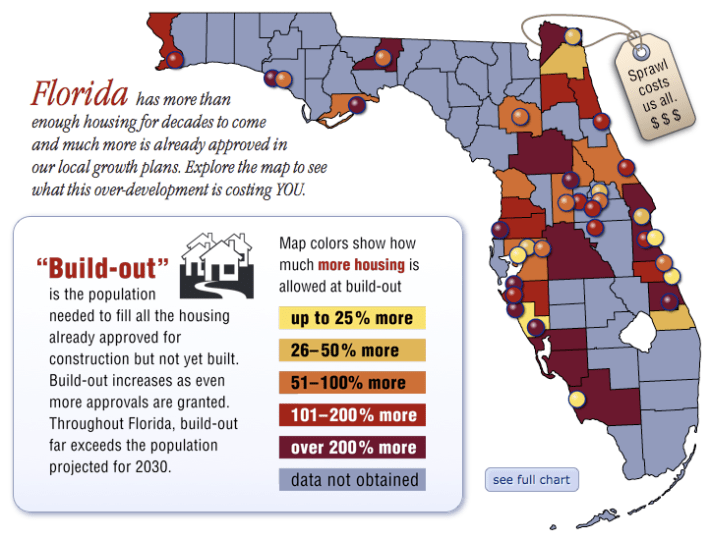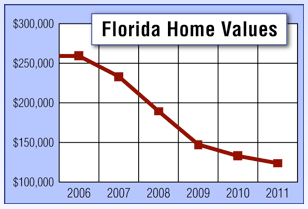We all know sprawl is costly to local communities. Roads, schools, sewers: It all adds up.
But the total price-tag is hard to determine, and that ambiguity undermines efforts at reform. What qualifies as sprawl? How much additional infrastructure is needed to support it?
That's why it's exciting that a group of concerned Florida homeowners has tackled this difficult question. Priceofsprawl.com shows that Florida communities pay dearly for "growth" that is often sold as a win-win. In reality, every dollar generated by new development in Florida costs taxpayers $1.34-$2.45. The more rural the setting, the higher the cost.
This project, presented as an interactive map, allows Floridians to see how sprawling development affects their local taxes and home values. Numbers were determined using existing impact studies and local comprehensive plans.
Just scroll over Lee County and the map will tell you that property values are down 54 percent here since 2006. Thirteen percent of the county's homes are vacant. In fact, this region of Florida -- the Greater Fort Myers area -- has been something of a poster child for the foreclosure crisis. "There is arguably no single housing market with a worse long-term outlook than southwest Florida, and the Cape Coral-Fort Myers region is the worst of these," wrote investment blog 24/7 Wall Street last week.
Despite all this, Lee County authorities have authorized a massive amount of new development. Local zoning laws have reserved enough land for new housing development to allow the building of 1.1 million homes, or 228 percent more than the current 346,000 homes. According to Priceofsprawl.com, building out that plan would cost suffering Lee County $3.12 billion in road construction, or about $10,000 per household, plus another $943 million to build the necessary schools. The oversupply of housing further drags down the value of existing homes.
“Our elected officials always said 'yes' wherever a development came forward – no matter the cost. This is our opportunity to tell our story our way," said Janet Stanko, of the North Florida Sierra Club, who oversaw the mapping project as part of the Amendment 4 campaign, an ultimately unsuccessful 2010 ballot initiative in Florida that would have made new development approvals subject to a public vote.
"When you have a growth in housing but you don’t have an increase in jobs, that makes an economy very unstable," she said.
Lee County is not unusual in the Sunshine State. Across Florida, local officials have approved development well in excess of the ability to support it, both fiscally and environmentally. Water supplies are already strained in many portions of the state. (Priceofsprawl.com characterizes Lee County's water supply as "empty.")
Meanwhile, the housing market has suffered in Florida more than most states. And the outlook is far from rosy.
Yet local officials in Florida, where about 19 million people live, have approved housing development that amounts to five times the state's current population -- about 100 million.
In 2010, Stanko and Florida homeowner Lesley Blackner teamed up to challenge this pattern. Through the statewide Amendment 4/Hometown Democracy Now Campaign, they hoped to wrestle decisions to convert rural land to housing from elected officials.
At the outset, the proposal was polling at 67 percent approval, said Stanko. The Florida Chamber of Commerce and the real estate industry fought hard against it, eventually eroding support down to about one-third, the result at the ballot box.
Despite the unusual nature of the Amendment 4 approach and its ultimate failure, the campaign helped Floridians become better informed about sprawl issues. Priceofsprawl.com continues that education process, even though the ballot issue for which is was built is history.
"What were putting out there is a big paradigm shift," said Stanko. "The paradigm out there right now is that growth is good and more is better. We’re trying to help people understand, 'No, it’s not paying for itself and you’re paying for it and oh, by the way, your neighborhoods are deteriorating faster because the money that would have been used to fix your street is going to those outlying areas.'"
I would love to see this tool replicated in cities around the country. In fact, can we start with my hometown: Cleveland?







